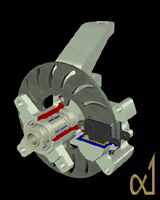

Alpha_1 Research System

|
|
|
|
Based on project research results, the Alpha_1 system is an advanced
research software base, supporting use and research in geometric
modeling (both ab initio and reverse engineering), high-quality
graphics, curve and surface representations and algorithms,
engineering design, analysis, visualization, process planning, and
computer-integrated manufacturing.
Solid models in Alpha_1 are represented by trimmed B-spline (NURBS) sculptured surface boundary representations. That is, the surfaces of a solid are represented explicitly, and linked together by shared edges. Our NURBS are Non-Uniform knot vector, Rational B-Splines of arbitrary order with tensor-product surfaces trimmed by NURBS curves. Alpha_1, implemented in C++, provides both command-language and graphical, menu-driven interfaces. An extensive 2D and 3D geometric modeling environment supports user-oriented operations for building up parts from dimensions, through basic geometry (points, lines, arcs, circles, etc.) through curve and surface constructions (profiles, sweeps, extrusions, etc.), shape operations (bend, twist, warp, etc.), and finally solids and boolean expressions (union, intersection, and difference) of solids. Time-varying models support animation, linkage design, simulations, etc. Volume primitives (box, cylinder, sphere, etc.) are represented by "parametric object types" which generate and cache spline-surfaced solid representations on demand. Similarly, mechanical design "features" (holes, pockets, etc.) may be grouped to support automatic NC code generation within a context of machine setups, fixturing, etc. Race Car DesignA Center's research faculty member teaches a design course for mechanical engineering undergraduates that includes designing, bullding, and racing real vehicles. Students use the Alpha_1 research system for integrated design, process planning, and manufacturing to help them build the custom subsystems they need. While the engines, overall dimensions, and safety requirements are prescribed, the rest of the vehicle is the work of the student teams. The brake system assemblies, suspension, power train encasements, and even specialized gear assemblies, for example, were designed and manufactured in Alpha_1.One of our two 1997 teams won first place in a four-hour endurance event, first place in braking, and fifth place overall. Out of 68 vehicles, only about 25 actually finished all the events (two of them were ours). To complete student projects of this complexity in this time frame would be impossible without the use of sophisticated modeling and manufacturing support. Even a few years ago, it was not possible to take on so many custom aspects, especially with the small budget available to the teams. Sponsored in part by the Center. Alpha_1 research in design and manufacturing environments, has led to present capabilities. We take pride, and hold a sense of co-achievement, in the teams' successes.
Telecollaborative Use of Alpha_1In addition to seeing and interacting with one another, VRAPP participants can see and interact with virtual objects in the environment. We have incorporated Utah's Alpha_1 tool into VRAPP so that all users can view and discuss a model, while one of them makes modifications. Seeing and interacting with a CAD model and other collaborators combines several benefits from the HP Shared 3D Viewer, MIT's StudioNet(TM), DIVE, and SPLINE. Unlike these projects however, we are working to tightly couple the CAD tool with the immersive environment: not only can participants display a mechanical model within VRAPP, but they can also use VRAPP to make detailed changes to the model. By choosing Utah's Alpha_1 as our CAD tool we provide an industrial-strength system that is both readily usable by a large group of existing experienced users and accessible and modifiable by our toolbuilders.Alpha_1 use with Pixel-Planes 5Sculptured models described using non-uniform rational B-spline (NURBS) surfaces are used for object representation for CAD/CAM, animation and visualization and virtual reality applications. Current systems for rendering of sculptured models on current graphics system, while faster than ever before, are not able to produce images at the frame rates necessary for applications involving VR and other immersive technologies. Hence, most VR environments are simplistic polygonal ones, instead of the more representative sculptured ones.This project involves both short and long-term research. In the short term, we have developed general-purpose parallel rendering algorithms for trimmed and untrimmed NURBS surfaces, and implemented them on Pixel-Planes 5 (Pxpl5). In the longer term we plan to target PixelFlow (PxFl), the machine currently under design at UNC, which will be some 20-40 times more powerful than Pixel-Planes 5. Furthermore, we are working on a flexible link between the display output routines of Alpha_1 and PPHIGS (a modified version of PHIGS used on Pxpl5). Then, the model being designed using Alpha_1 can be constantly updated to Pxpl5 and can be independently viewed. We also make use of the STC video network to display the output on a monitor at Utah (at NTSC resolution). This research and system provides enabling technology for work in collaborative and immersive design. This collaboration was started in August 1993. We have currently reached a stage where we can render complex untrimmed sculptured models at interactive rates on Pxpl5. Our current algorithm makes use of multiple GP's (i860 graphics processors) on Pxpl5 and distributes the model among them. It uniformly tessellates the surfaces into triangles and makes use of frame-to-frame coherence by caching the triangles and performing incremental evaluations corresponding to each frame. The degree of tessellation of a surface is decided on-line based on its current position on the screen. A preliminary comparison of the implementation of our algorithm on the Reality engine shows a 4-6 times speed-up over SGI's GLs implementation. The performance of the algorithm on Pixel-Planes 5 is much faster than SGI Reality engine. On the Pixel-Planes we have been able to render up to 10000 untrimmed and 1500 trimmed surfaces at interactive rates (more than 15 frames a second).
|
| Home | Research | Outreach | Televideo | Admin | Education |